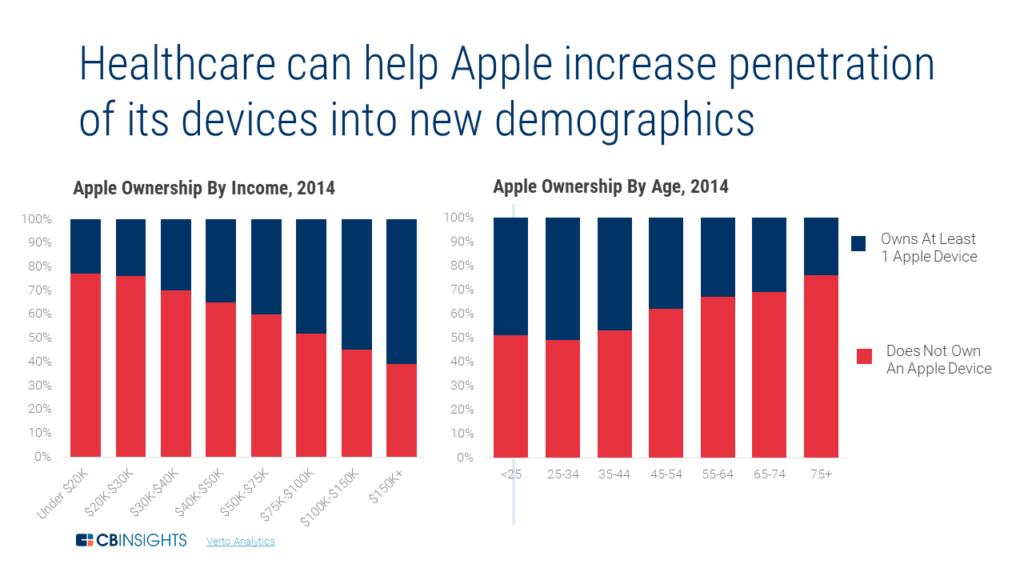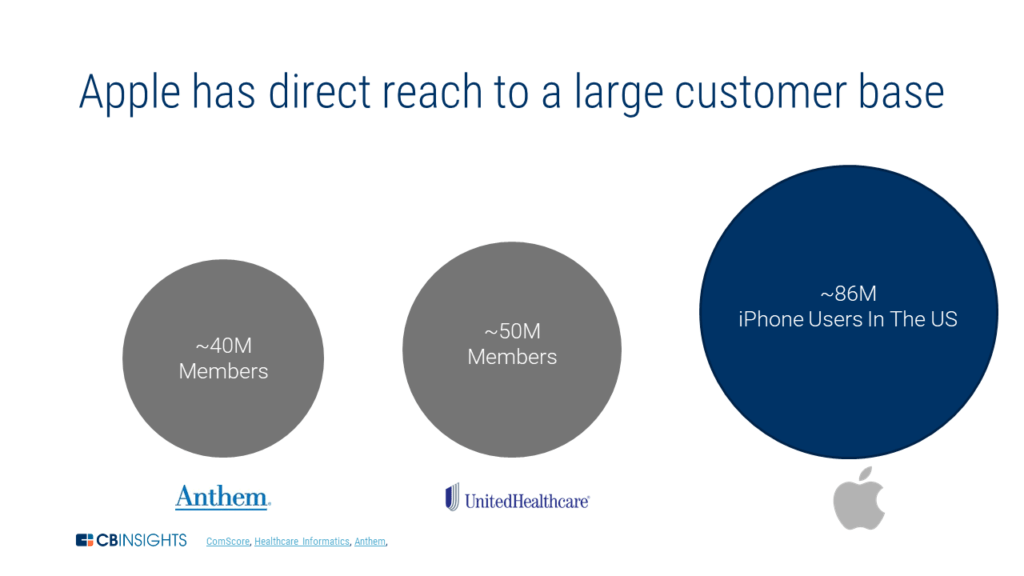From CB Insights, Jan. 8:
The market opportunity in healthcare is huge, and Apple sees healthcare
and wellness as a core part of its app, services, and wearables
strategies. Now the company is aiming to become your personal health
record, jumping into research, medical devices, and more.
As Apple CEO Tim Cook has said, the healthcare market makes the
smartphone market look small. In fact, with over $7 trillion in health
spending per year, it’s already almost 10% of global GDP.
With the release of the Apple Health Record and Apple Watch with a
single-lead ECG, it’s evident that Apple has officially entered the
healthcare space
The company hopes to build the first healthcare platform
friendly to third parties, with the personal health record at the
center.
In this report, we analyze Apple’s ongoing impact on clinical research and studies, its strategy in building a personal health record, and where the company’s going next in healthcare.

Table of Contents
Why Apple is moving into healthcare
There a few major reasons for Apple’s moves into the highly regulated world of healthcare.
Tech giants, for one, are becoming more competitive with one
another, encroaching on territories Apple has historically dominated:
Google is making phones, Amazon is focusing on home hardware, the
wearables market is saturated, and so on.
As tech giants continue to move into Apple’s territory, healthcare
can help the company differentiate its products and further reach its
core goals, which include:
- Selling more high-margin hardware
- Increasing switching costs from its ecosystem
- Expanding its service offerings (Apple Cloud, App Store, etc.)
Keeping
people in its ecosystem is also how Apple has managed to create an
attractive third-party developer ecosystem in its app store. The lack of
an existing third-party developer ecosystem for healthcare data is an
open opportunity for Apple.
This is more conceivable thanks to the proliferation of FHIR (Fast
Healthcare Interoperability Resources) technology, which looks to
increase interoperability among hospitals, physicians, and other
relevant parties.
FHIR creates standards for different data elements so that developers
can build application programming interfaces (APIs) that can be used
to access datasets from different systems. Apple is part of the group
pushing this standard forward.
Finally, Apple can use healthcare as a means to distribute its
products into the hands of demographics that it has traditionally had a
tough time penetrating: the low-income and elderly populations.
Considering these groups are disproportionately more likely to be sick,
Apple can position itself as a tool to improve outcomes and distribute
via family members or insurance carriers (which we’ll dive into later in
this piece).

Apple’s edge in health
 While healthcare might seem like an area outside of Apple’s
expertise, it has many advantages relevant to the space, its brand being
one of the biggest.
While healthcare might seem like an area outside of Apple’s
expertise, it has many advantages relevant to the space, its brand being
one of the biggest.
Various existing healthcare players have notoriously terrible brand
and customer experience, which has been Apple’s focus as a company.
As healthcare moves to a more proactive model, which requires
reaching out to patients, having a strong brand is a major
component. Apple’s attention on user privacy is notable here, especially
compared to other tech giants entering the healthcare space.
Its strong brand has led to direct relationships with iPhone users,
giving Apple a distribution and size advantage. When Apple released the
Health app, it immediately got into the hands of its users. This also
gives Apple leverage when negotiating or talking to existing players in
the system, compared to a startup which doesn’t have that same size.
Apple has the aggregate leverage of its entire user base to negotiate
with — as of December 2016, there were 85.8M iPhone owners older than
13 in the US alone. (For comparison, UnitedHealthcare has ~50M medical
enrollees.)

The Apple brand includes an ecosystem of products that work
seamlessly with each other. This makes consumers invest more of their
time, data, and preferences into Apple products — which makes them
indispensable.
If buying an Apple product, for example, yields a smoother
user journey and connects other existing data from a user’s Apple
account, then there’s more of an incentive to buy Apple. Few healthcare
incumbents can tap into any similar ecosystem effect.
The company’s control over both software and hardware is ultimately
what gives Apple such a strong brand and consumer experience. Apple is
bolstering its software offering as a whole through a number of recent
acquisitions of artificial intelligence companies, including Silk
Labs (CB Insights clients can see the full list of deals here)...
...
MUCH MORE
While healthcare might seem like an area outside of Apple’s expertise, it has many advantages relevant to the space, its brand being one of the biggest.



